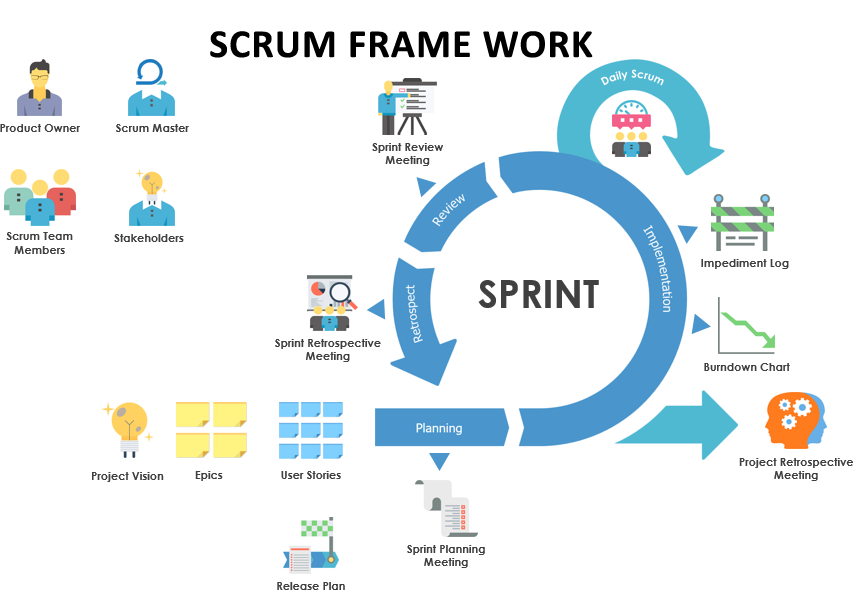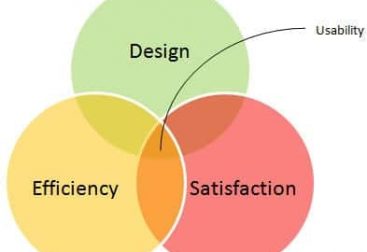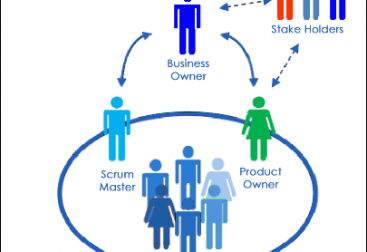What is Scrum
- Scrum is a subset of Agile. It is a lightweight process framework for agile development, and the most widely-used one.
- Scrum existed before Agile.
- Scrum respects the Agile Manifesto.
- Scrum framework within which people can address complex adaptive problems, while productively and creatively delivering products of the highest possible value.
- Scrum is: • Lightweight • Simple to understand but Difficult to master
- The Scrum framework consists of Scrum Teams and their associated roles, events, artifacts, and rules.
- Implementing only parts of Scrum is not Scrum. Scrum is immutable. Scrum needs to be adhered exactly what prescribed in scrum framework
- Each component within the framework serves a specific purpose and is essential to Scrum’s success and usage.
- It divides complex problems into a small scope of short term iterations. For each iteration, just enough work is planned that can be completed within that short iteration of a few weeks. There is no big scope of work spanning a long duration.
- Scrum is founded on empirical process control theory, or empiricism. Empiricism asserts that knowledge comes from experience and making decisions based on what is known. Scrum employs an iterative, incremental approach to optimize predictability and control risk.
- It uses a small team to perform these few weeks of work. It requires them to increase the visibility of work or product information as they travel this iteration.
- The small team creates a product Increment which is a usable outcome, at the end of these few weeks. The Increment is shared with stakeholders for inspection and feedback is solicited
- From this feedback and experience, new clarity emerges and knowledge is obtained. The scope and plan for the next iteration is adjusted based on this new knowledge.
- You can equate the traditional “trial and error” model to empiricism. Each iteration is a trial to solve a problem and gain more clarity.
- Reducing risk increases the probability of meeting the goal. So, empiricism applies an iterative, incremental approach to optimize predictability and control risk.
- Scrum has been used to develop software, hardware, embedded software, networks of interacting function, autonomous vehicles, schools, government, marketing, managing the operation of organizations and almost everything we use in our daily lives, as individuals and societies
Scrum Pillars
- The three pillars of empiricism are the heartbeat that upholds every implementation of the empirical process control.
The pillars are
- Transparency,
- Inspection, and
- Adaptation
Transparency
Transparency requires that significant aspects of the process be visible and defined by a common standard so stakeholder and scrum team share a common understanding of what is being seen and working
A common language referring to the process must be shared by all participants; and, Those performing the work and those inspecting the resulting increment must share a common definition of “Done”.
So, The definition of “Done” is a standard for ensuring Transparency.
Inspection
Inspection requires that Scrum users frequently inspect the Scrum artifacts and progress towards a Sprint Goal to detect undesirable variances.
Their inspection should not be so frequent that inspection gets in the way of the work. Inspections are most beneficial when diligently performed by skilled inspectors at the point of work. we can inspect through the scrum event and most frequently as possible.
Adaptation Adaptation requires that, in the event of unacceptable variances, the Scrum Team must make adjustments as soon as possible to minimize further deviation.
Scrum prescribes four formal events for inspection and adaptation, as described in the Scrum Events.
Scrum Values
The Scrum Team lives by Scrum Values so that the Scrum Pillars come to life.
Scrum values are a set of fundamental qualities underpinning the Scrum framework;
Scrum five values: commitment, courage, focus, openness, and respect. Being proficient in living these values brings the Scrum pillars of Transparency, Inspection, and Adaptation to life and builds trust for everyone.
The Scrum Team members learn and explore these values as they work with the Scrum events, roles, and artifacts. These values are seen as another checkpoint to compare the behavior within the Scrum Team to see if the behavior reflects the understanding or just the mechanics.
- Commitment : Commitment of every team member to achieve the goals of the Scrum Team. Commitment in following the pillars of empiricism and self-organization and using them to achieve the goals.
- Courage: Courage to work on tough problems. Courage to do the right thing by accepting that the future cannot be predicted and responding to emerging change. Courage helps everyone to be grounded in reality not giving into personal pride.
- Focus : Focus of the team on prioritizing and completing the Sprint work to achieve the goals of the Scrum Team. Focus helps to avoid doing other things not related to the Sprint Goal.
- Openness: Openness of the Scrum Team and its stakeholders in expressing and facing the facts and truths about all the work and challenges with performing the work, thereby increasing transparency. Openness to collaborate with others with the highest amount of transparency.
- Respect: Respect each other as capable and independent people so that it can provide a trustworthy environment to learn and share.
- Successful use of Scrum depends on people becoming more proficient in living these five values.
- People personally commit to achieving the goals of the Scrum Team.
- The Scrum Team members have courage to do the right thing and work on tough problems. Everyone focuses on the work of the Sprint and the goals of the Scrum Team. The Scrum Team and its stakeholders agree to be open about all the work and the challenges with performing the work.
- Scrum Team members respect each other to be capable, independent people.






